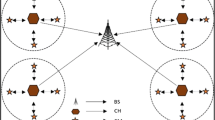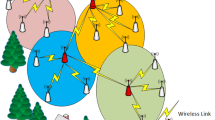Abstract
Wireless Sensor Networks (WSNs) have recently achieved tremendous success at both research and industry levels. WSNs are currently implemented in many areas, such as the military, environmental monitoring, and medicine. WSN nodes are battery-operated, and energy saving is critical for their survival. Several research papers have been published on how to optimize power usage. In this paper, we focus on improving power consumption by optimizing data transfer. We propose an Energy-Efficient Partitioning Algorithm to reduce data transfer and consequently improve power consumption. Using data collected from a real WSN in the City of Moncton, we implemented and compared the performance of the proposed algorithm with another data reduction algorithm. Experimental results show that our algorithm outperforms a recent data reduction technique in terms of power saving.
Access this chapter
Tax calculation will be finalised at checkout
Purchases are for personal use only
Similar content being viewed by others
References
Anastasi, G., Conti, M., Di Francesco, M., Passarella, A.: Energy conservation in wireless sensor networks using data reduction approaches: a survey. Int. J. Comput. Eng. Res. 7(3), 537–568 (2013)
Karim, L., Anpalagan, A., Nasser, N., Almhana, J.: Sensor-based M2M agriculture monitoring systems for developing countries: state and challenges. Netw. Protoc. Algorithm J. 5(3), 68–86 (2013)
MacQueen, J.B.: Some methods for classification and analysis of multivariate observations. In: 5th Berkeley Symposium on Mathematical Statistics and Probability, pp. 281–297. University of California Press (1967)
Tsai, K., Ye, M., Leu, F.: Secure power management scheme for WSN. In: 7th ACM CCS International Workshop on Managing Insider Security Threat, MIST 2015, pp. 63–66 (2015)
de Souza, K., Fournier-Vigier, P., Almhana, J.: Early detection of abnormal residential water consumption. Technical report (2017)
Said, J.E., Karim, L., Almhana, J., Anpalagan, A.: Heterogeneous mobility and connectivity-based clustering protocol for wireless sensor networks. In: ICC 2014, pp. 257–262 (2014)
Almhana, C., Choulakian, V., Almhana, J.: An efficient approach for data transmission in power-constrained wireless sensor network. In: ICC 2017, pp. 4058–4064 (2017)
Liu, Y., Li, Z., Xiong, H., Gao, X., Wu, J., Wu, S.: Understanding and enhancement of internal clustering validation measures. IEEE Trans. Cybern. 43(3), 982–994 (2013)
Pantazis, N.A., Nikolidakis, S.A., Vergados, D.D.: Energy-efficient routing protocols in wireless sensor networks: a survey. Commun. Surv. Tutorials 15(2), 551–591 (2013)
Ye, W., Heidemann, J.: An energy-efficient MAC protocol for wireless sensor networks. In: IEEE Computer and Communications Societies, pp. 1567–1576 (2002)
Younis, O., Fahmy, S.: HEED: a hybrid, energy-efficient, distributed clustering approach for ad hoc sensor networks. IEEE Trans. Mob. Comput. 3(4), 366–379 (2004)
Patil, S.A., Mishra, P.: Improved mobicast routing protocol to minimize energy consumption for underwater sensor networks. Int. J. Res. Sci. Eng. 3(2), 197–204 (2017)
Liao, T.W.: Clustering of time series data – a survey. Pattern Recogn. 38(11), 1857–1874 (2005)
Smith, B.A., Wong, A., Rajagopal, R.: A simple way to use interval data to segment residential customers for energy efficiency and demand response program targeting. In: ACEEE Summer Study on Energy Efficiency in Buildings (2012)
Lavin, A., Klabjan, D.: Clustering time-series energy data from smart meters. Energy Effi. 8, 681–689 (2015)
Acknowledgement
This work is supported in part by an NSERC Discovery Grant awarded to Prof. Jalal Almhana and the Youth 1000 Funding of Prof. Philippe Fournier-Viger from the NSFC. We are grateful to the City of Moncton who provided us with the data.
Author information
Authors and Affiliations
Corresponding author
Editor information
Editors and Affiliations
Rights and permissions
Copyright information
© 2018 ICST Institute for Computer Sciences, Social Informatics and Telecommunications Engineering
About this paper
Cite this paper
de Souza, K.V.C.K., Almhana, C., Fournier-Viger, P., Almhana, J. (2018). Energy-Efficient Partitioning Clustering Algorithm for Wireless Sensor Network. In: Li, C., Mao, S. (eds) Wireless Internet. WiCON 2017. Lecture Notes of the Institute for Computer Sciences, Social Informatics and Telecommunications Engineering, vol 230. Springer, Cham. https://doi.org/10.1007/978-3-319-90802-1_2
Download citation
DOI: https://doi.org/10.1007/978-3-319-90802-1_2
Published:
Publisher Name: Springer, Cham
Print ISBN: 978-3-319-90801-4
Online ISBN: 978-3-319-90802-1
eBook Packages: Computer ScienceComputer Science (R0)




